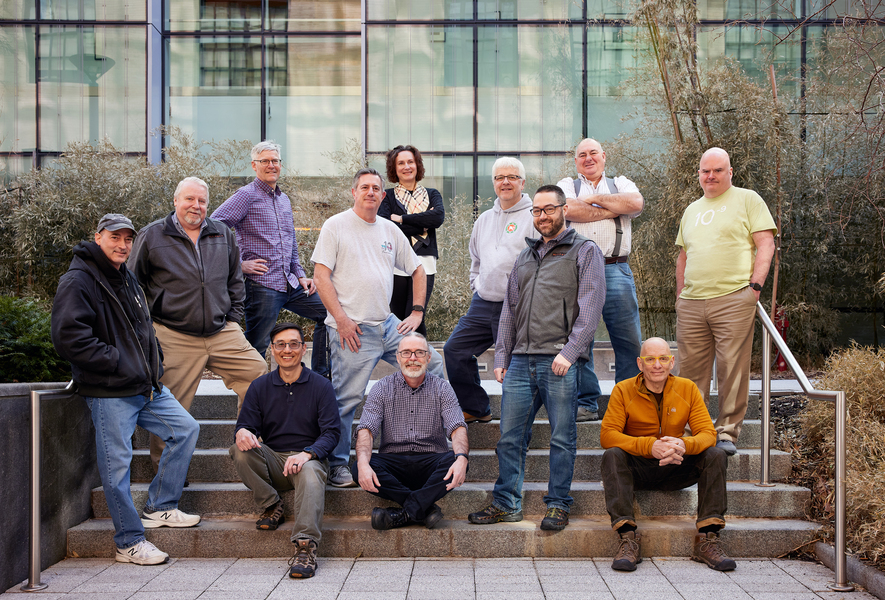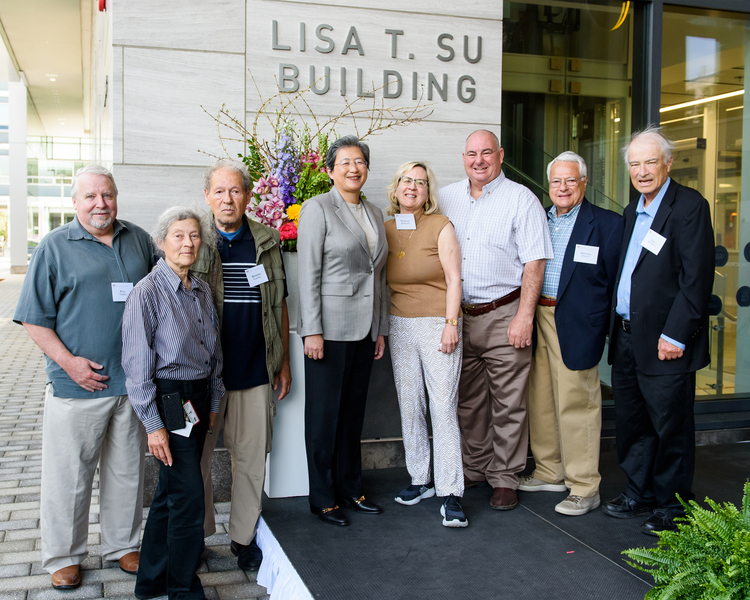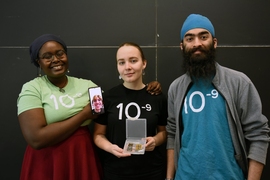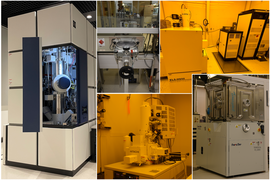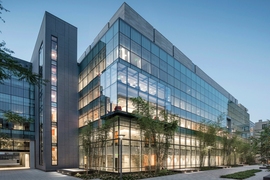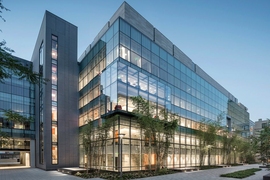When MIT.nano opened in 2018 in Building 12, now the Lisa T. Su Building, it became the new home at MIT for suites of nanoscale characterization and fabrication equipment, including those previously housed in Building 39. And when a core team of people moved along with these tools and instruments, MIT.nano also became the repository of more than 400 combined years of MIT and technical experience.
A core group of MIT.nano’s research staff and technicians come from long tenures in Building 39’s Microsystems Technology Laboratories (MTL) and NanoStructures Laboratory (NSL). While the entire team has expertise in processes and equipment throughout the facility, their roles roughly divide into these areas: Bob Bicchieri, Donal Jamieson, Eric Lim, and Gary Riggott primarily support vacuum equipment for etching and depositing materials; Mark Mondol, Scott Poesse, Dave Terry, Paul Tierney, and Dennis Ward are among the specialists working in lithography and chemical processing; Kurt Broderick and Jim Daley provide broad support for fabrication and characterization processes; Dan Adams, Paul McGrath, and Tim Turner support the building and infrastructure; and Ludmila Leoparde serves as financial officer.
Behind their job titles, these staff members fill many roles. They are educators and safety guides, the first stop for users-in-training; experts on running and repairing sophisticated tools that cost upwards of a million dollars; and storehouses of technical knowledge. After construction finished in 2018, they were essential to the successful development of MIT.nano as an operational facility, navigating — through a pandemic — the shift in operations from other labs to MIT.nano. On top of it all, they’re generous colleagues and genuine friends.
“These individuals are the glue that holds everything together,” describes Kristofor Payer, assistant director of operations at MIT.nano. “Just look at the last five years. They’ve led two buildings through Covid and never dropped the ball.”
No substitute for experience
In helping users reach their objectives, the staff draw on deep knowledge of processes that were developed five, 10, even 20 years ago — as well as an awareness of the broad range of work happening in the lab right now.
“Our team built a cross-departmental facility,” says MIT.nano Director Vladimir Bulović, the Fariborz Maseeh Professor in Emerging Technology. “We support the needs of users from electrical engineering, biology, chemical engineering, and many other disciplines. These researchers bring their own unique perspectives and knowledge, and the MIT.nano staff, as ‘technical polyglots,’ tie this community together.”
A common misconception among students is that a methodology they’ve read about in a scientific paper can be replicated exactly in a different facility under different conditions. The reality is more complicated, says Donal Jamieson, a vacuum specialist and MIT staffer since 2003, but “we’ve got so much experience at this point that as long as they explain what they’re trying to achieve, we can say, ‘We’ve done that; we can do that.’”
And when things don’t go according to plan, these are the troubleshooters you want by your side. “I love that feeling of being able to bring a down machine back up,” says Scott Poesse, a lithography specialist at MIT since 1995. “It’s one of my driving forces: to look for things that are broken and fix them.”
“You don’t take your car apart just to learn how it works,” notes Bob Bicchieri, who recently celebrated his 40th work anniversary at MIT. “You do that when something goes wrong — and gain a deeper understanding of the machine each time.”
“The longer we’ve gone on and the more obstacles we’ve overcome, the more collective knowledge we’ve got on how to deal with these obstacles,” adds Dave Terry, who has been providing lithography support at MIT since 2001.
Education and innovation in the cleanroom
Vicky Diadiuk ’73, ScD ’78 recently retired after 27 years of overseeing the MTL cleanroom and staff in Building 39. For years she watched their interactions with students, and she doesn’t hesitate to classify them as educators. “They’re teaching good behavior in the lab. They’re teaching what the machine does and why it would be helpful. So absolutely — they’re instructors, they’re mentors, and they’re role models.”
The question research specialist Jim Daley most appreciates after 27 years of working with students is: “‘Hey Jim, if that tool breaks, can I help you fix it?’ The people that really want to know the insides and outs of things, they’re the people that are going on to bigger and better things,” he says.
When interacting with students, the staff members look for methodical thinking, with the discipline to plan and track each step of a process — and also flexibility and creativity, which can be modeled but not easily taught. Lithography team member Dennis Ward has learned since coming to MIT in 2000 never to dismiss an unconventional idea. He recalls when one student, Luis Velásquez-García SM ’01, PhD ’04, suggested that in lieu of 3D extruded structures, they might fabricate 2D structures with slots that snapped together, almost like a paper doll. Both the idea and the student did well: Versions of those 2D structures are now used in thrusters for satellites and Velásquez-García is now a principal research scientist at MTL.
Staffers reminisce about other now-successful technologies they’ve seen developed in part in MIT laboratories, from quantum dot displays and foldable glass screens to MEMS accelerometers used in everything from car airbags to video game controllers to a host of biomedical devices.
“That’s the stuff that keeps you going,” Ward says. “Someone says something and your initial thought is, ‘That’s nuts. Can this work or not?’ When it does, it’s very rewarding.”
Sometimes the outside-the-box thinking comes from the staff themselves. Ward recalls an instance when some users needed to protect the deep features on their wafer in a way MTL’s tools did not accommodate. He went to a craft store in Cambridge's Central Square. “We got the kind of air pen they use to make T-shirts at the beach. We used that to atomize and spray the resist,” he remembers.
Continuity and change
In the MTL facility, where much of the MIT.nano staff first solidified as a team, necessity was the mother of practical ingenuity. Larger tools were brought in and out through windows. If equipment was too heavy for one person to move, five would jump in to help.
“That’s one of the things I always liked,” says project technician Tim Turner, who started at MTL in 2001. “There was no ‘can’t.’ It’s just ‘how.’”
The past five years pushed “how” into new territory. The opening of MIT.nano posed considerable challenges — relocating equipment, installing new tools and instruments, coordinating construction projects, and acclimating people to the new space, all without disrupting ongoing research. Then, less than a year into the operation, the team had to figure out how to do it during a pandemic. During the shutdown, members of the team came to MIT.nano in staggered shifts to make sure the equipment and laboratories were in working order and safe; and in June 2020, MIT.nano’s technical staff were among the first people to return to campus full time so researchers could resume their work.
Since then, MIT.nano has grown to support researchers across many disciplines at MIT with over 150 tools and instruments. The technical team maintains a mix of new equipment with older ones, some of which were repurposed as the applications of nanoscale research expanded far beyond the original scope of the semiconductor industry. Some longtime technical staff speak of the tools almost like old friends. Turner expresses a certain nostalgia for a dicing saw he used to maintain. The “new” one, for the record, is 17 years old; “I’m coming around to it,” he says.
Enduring connections
By Bicchieri’s count, he’s attended more than 100 PhD thesis defenses. For him and his colleagues, these presentations often represent a satisfying culmination of a collaboration in the lab.
“The mentorship this tremendous group of staff has provided our students over the years has had immense value,” says Anantha Chandrakasan, dean of the MIT School of Engineering and the Vannevar Bush Professor of Electrical Engineering and Computer Science. “From introducing undergraduate students to tools and advanced concepts to helping hundreds of PhD students complete their dissertations.”
PhD candidates often thank specific staff members in their dissertations. Paul McGrath was one of those acknowledged by Lisa T. Su ’90, SM ’91, PhD ’94, who is now the CEO of Advanced Micro Devices. Nearly 30 years later, he found himself greeting her at the 2022 ceremony that affixed her name to Building 12.
Now in retirement, McGrath boasts the longest MIT tenure of the MIT.nano staff, having arrived in 1979. When asked what kept him at MIT for four decades, McGrath’s answer is simple: “Every day there’s a lot of interesting things going on,” he reflects. “They say you can learn something new every day here on this planet, but if you work at MIT, you can learn something new every hour if you keep your eyes and ears open.”
Vacuum specialist Eric Lim says he doesn’t miss the adversarial dynamics of the corporate world he left behind when he came to MIT in 2004. Over the years his team has backed each other up, sharing the benefit of their own expertise along with countless meals and jokes. Lim says there’s something about the fab environment that leads to enduring connections with students, too. “I think it comes with sharing the struggles of developing the processes and having problems with the tools and working together to solve them.”
Mark Mondol has been at MIT since 1990, long enough to see his former students return with their kids for college visits. Having run the NanoStructures Lab in Building 39 before it transferred to MIT.nano, he’s also helped several NSL alumni hit the ground running when they’ve been hired at other universities: “I’ve gotten numerous phone calls over the years: ‘Mark, what was that tool we used in the lab? How did you set up this process?’”
When research specialist Gary Riggott was cleaning out his old space in preparation for the 2018 move, he found a pile of notebooks with handwritten notes of experiments past. Despite the growing age gap between himself and the student population, “I give the same assistance that I did 20 years ago,” says Riggott. “We want to help the students be successful.”
Poesse agrees: “I think probably the biggest surprise for people outside the building looking in is that there is this tight team inside. Nobody slips through the cracks. Everybody’s taken care of, whether it’s the students or each other.”
